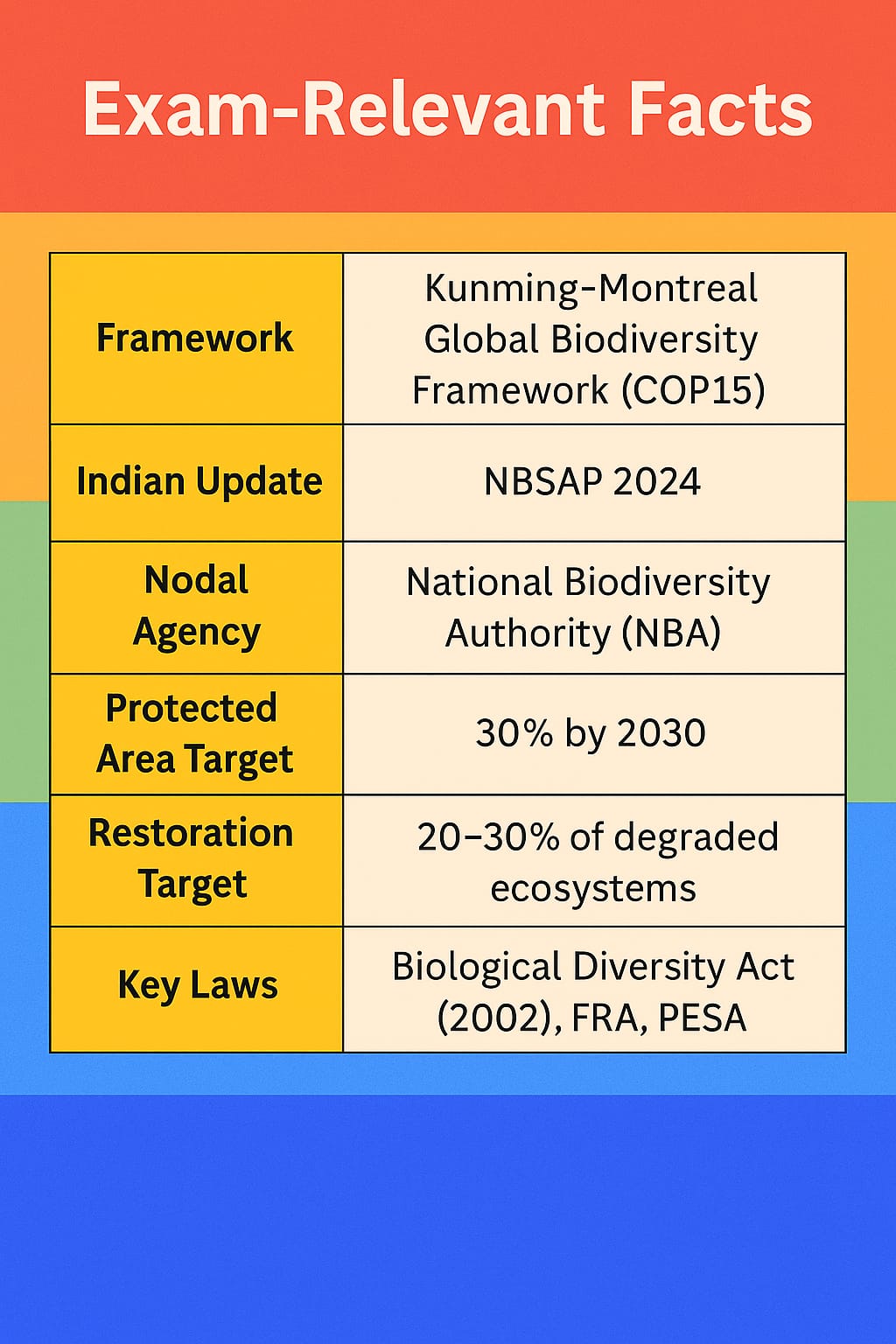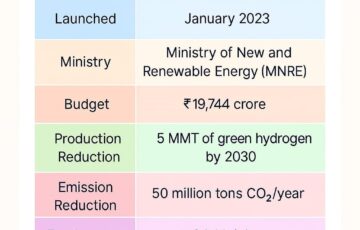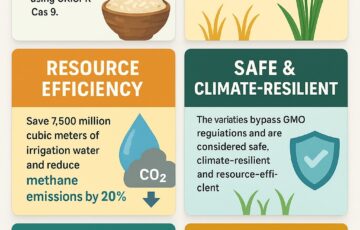India’s National Biodiversity Strategy and Action Plan (NBSAP) – 2024 Update
India’s National Biodiversity Strategy and Action Plan (NBSAP) – 2024 Update
Overview
India has updated its National Biodiversity Strategy and Action Plan (NBSAP) to align with the Kunming-Montreal Global Biodiversity Framework (GBF), also known as the Kunming-Montreal agreement or the post-2020 global biodiversity framework, adopted at COP15 of the Convention on Biological Diversity (CBD) in 2022. This update aims to address the pressing issue of biodiversity loss and promote the sustainable use of biodiversity, contributing to diversity in the world.
The updated NBSAP, a key component of National Biodiversity Strategies and Action Plans (NBSAPs) worldwide, sets national targets for biodiversity conservation, sustainable use of biological resources, and equitable benefit-sharing from genetic resources, in line with global biodiversity targets for 2030 and the 2050 vision for biodiversity.
Objectives of the Updated NBSAP
- Align with Kunming-Montreal Global Biodiversity Framework (GBF)
- Address national priorities in biodiversity protection
- Integrate biodiversity conservation with climate, development, and livelihoods
- Enhance community and ecosystem resilience
- Contribute to the 2030 target world and 2050 vision for global diversity
Key Focus Areas
1. Protection of Endemic and Threatened Species
- Conservation of species unique to India such as the Great Indian Bustard, Lion-tailed macaque, and Nilgiri Tahr
- Emphasis on in-situ and ex-situ conservation methods to prevent species extinction
- Expansion of protected areas, wildlife corridors, and biosphere reserves to combat biodiversity loss
2. Restoration of Degraded Ecosystems
- Restoration of wetlands, mangroves, forests, grasslands, inland water, and river basins
- Integration with programs like Green India Mission and National Mission on Biodiversity and Human Well-Being
- Promotion of Nature-Based Solutions (NbS) for climate resilience and ecosystem services
- Sustainable management of restored ecosystems to ensure long-term benefits
3. Community-led and Tribal Conservation
- Strengthening Biodiversity Management Committees (BMCs) and People’s Biodiversity Registers (PBRs)
- Ensuring compliance with the Biological Diversity Act, 2002
- Engagement of indigenous peoples and local communities, including Scheduled Tribes and forest dwellers under FRA and PESA Acts
Alignment with Global Targets
India’s updated plan supports the following Kunming-Montreal Global Biodiversity Framework (GBF) goals:
- Protect 30% of land and coastal and marine ecosystems by 2030 (30 by 30 target)
- Restore 20–30% of degraded ecosystems
- Reduce extinction rates and ensure genetic diversity conservation
- Mainstream biodiversity into sectors like agriculture, urban development, and health
- Equitable sharing of benefits from Digital Sequence Information (DSI)
- Pollution reduction to enhance biodiversity conservation
Institutional Framework
Nodal Agency: National Biodiversity Authority (NBA) under the MoEFCC
Coordination with:
- State Biodiversity Boards (SBBs)
- Panchayats and Urban Local Bodies (ULBs)
- Other ministries (Tribal Affairs, Agriculture, Fisheries)
Funding from:
- Green Climate Fund (GCF)
- CAMPA Fund
- National Biodiversity Fund
- Proposed global biodiversity fund
Implementation and monitoring framework:
- Enhanced monitoring indicators aligned with global biodiversity targets
- Regular assessment of progress towards biodiversity targets
- Capacity-building for effective implementation at all levels
New Strategic Additions
- Gender-responsive biodiversity policy
- Biodiversity integration in disaster risk reduction and urban resilience
- Technology use for biodiversity tracking and digital documentation
- Synergies with climate change adaptation policies
- Strategies to address invasive alien species
- Improved spatial planning for biodiversity conservation
Exam-Relevant Facts (UPSC Biodiversity Topics)
|
Item |
Details |
|
Framework |
Kunming-Montreal Global Biodiversity Framework (KM-GBF) |
|
Indian Update |
NBSAP 2024 |
|
Nodal Agency |
National Biodiversity Authority (NBA) |
|
Protected Area Target |
30 by 30 target |
|
Restoration Target |
20–30% of degraded ecosystems |
|
Key Laws |
Biological Diversity Act (2002), FRA, PESA |
|
Global Convention |
Convention on Biological Diversity (CBD) |
Quick Revision Points (Biodiversity Notes)
- India is revising its NBSAP for the first time since 2002
- NBSAP 2024 focuses on endemic species, community participation, and ecosystem restoration
- It is India’s key strategy for achieving nature positive development
- The plan addresses biodiversity finance and supports the creation of a global biodiversity fund
- Emphasis on sustainable use of biodiversity (biodiversidad in Spanish) and maintaining ecological integrity
- The Kunming Declaration set the stage for the Kunming-Montreal Global Biodiversity Framework (GBF)
- NBSAP 2024 aims to contribute to global efforts in preserving diversity in the world
- The updated NBSAP aligns with the goals set by the Convention on Biological Diversity (CBD)
- National Biodiversity Strategies and Action Plans (NBSAPs) are crucial tools for implementing the CBD at the national level











